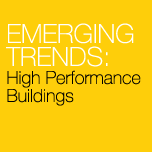Carl Seville, GBA Advisor
It isn't easy to meet the energy and water requirements set by the LBC

The Living Building Challenge uses the flower as both its logo and inspiration for their transformational building certification program.
I spent most of a day recently in a seminar on the Living Building Challenge (LBC), a self-described philosophy, advocacy tool, and certification program for sustainable building. If people outside the industry think that existing green building programs are pie-in-the-sky and touchy-feely, put together by granola-eaters, then they are going to have to adjust their scales for the LBC. Currently in its 2nd version with a new release planned for 2012, it does have many similarities with other green certification programs, although it is in some ways both simpler and more complex than anything else in the marketplace.
Forget sustainable — how about restorative?
“Green” is often used interchangeably with “sustainable,” and neither word yet does justice as a name for what we are all working towards.
In a lecture many years ago I heard Michael Braungart discuss his problem with the word “sustainable” by asking the audience if they were asked how their marriage was doing, would they want to respond “sustainable”? He advocated for moving towards a restorative model, and this is what the LBC is doing.
Their goal is to create structures that not only have a lower impact on the environment, but change the paradigm of how we build so that those structures become restorative to our ecosystems. The creators believe that over the past 200 years we have used technology to separate ourselves from the environment and now it is time for us to reconnect with it.
Probably the key difference between LBC and all other certification programs is that certification is based on a full year of building operation instead of estimated or modeled energy and water use.
The flower as guiding principle
The LBC is broken down into seven “petals,” each with a subset of twenty “Imperatives.” Projects are separated into four typologies: Neighborhood, Building, Landscape and Infrastructure, and Renovation.
Building is the most common, covering all new buildings and any work on existing buildings exceeding minor improvements; those are covered by the Renovation typology. Landscape and Infrastructure are unconditioned projects that do not include physical structures as the primary program, although they can include park-like structures such as amphitheaters, restrooms, roads, bridges, and sports facilities. A Neighborhood includes multiple buildings in a single campus, drawing heavily on the principles of New Urbanism.
The first five petals look very similar to categories in many traditional green building programs: Site, Water, Energy, Health, and Materials. While in last two, Equity and Beauty, the LBC appears to differentiate itself, many of the imperatives push the envelope the furthest.
“Imperative” is another name for requirements or prerequisites, so familiar to those certifying green buildings. As in other programs, imperatives are required, except for certain exceptions, based on project type. For example, Neighborhood and Building typologies require that all imperatives be met. Landscape and Infrastructure are exempt from four and Renovation is exempt from seven.
Finally, LBC classifies projects in one of six “Transects,” a variation on those created by New Urbanism. They include Natural Habitat, Rural Agriculture, Village, General Urban, Urban Center, and Urban Core. Each of these transects affect the specific requirements of each imperative. For example, one imperative requires including food production on site, with the portion of the site devoted to this agriculture ranging from 80% in the Rural Agriculture transect to 0% in the Urban Core.
You say prerequisite, I say imperative
What appears to be the simplicity of the LBC is the list of 20 Imperatives which (with certain exceptions as mentioned above) must be met for certification. There are no points to add up nor different levels of certification (although partial certification is now available); you either make it or you don’t. This does, at first glance, appear simple, but there are many exceptions and interpretations of imperatives. These serve to both make the program more accessible to ambitious projects that otherwise wouldn’t meet certification as well as to make it more complex that it first appears.
I won’t list all 20 Imperatives in this article — you’ll have to go to the LBC website for that — but I will review some of the key ones, and how they are interpreted. In my mind, the most important imperatives are #5, Net Zero Water, #6, Ecological Water Flow, and #7, Net Zero Energy.
Net zero water means just that — the project must have a closed-loop water system that uses rain and wastewater for all potable and non-potable water on the site. Interesting exceptions to this lofty goal include drilling an on-site well, or, if after submitting a complete water capture and reuse design to the local jurisdiction you are turned down, a project is allowed to use an outside water source.
Ecological water flow is sort of the opposite of net zero water. All storm and sanitary discharge must be managed on site. No physical connection to a municipal sewer system is allowed. If the codes require a sewer connection, you must install a valve so you can disconnect after project is completed. Options to meet this imperative include installation of a septic system or an on-site sewage digester.
Finally, Net Zero Energy means what it says (including no combustion equipment allowed in the project); however it is more rigorous than the common definition. Renewable power must be generated on-site, not purchased from a local utility. Exceptions for this imperative include fuels cells powered by hydrogen created from electrolysis, recreational fireplaces in certain institutional projects, and biogas created on-site used for cooking fuel.
Slow and steady
To date, there have been three buildings certified as Living Buildings, one residential project Petal (partially) certified, and several projects in their first year of occupancy phase.
My biggest concerns with the program is that there is, at this point, very little guidance through the process, although they are starting to offer consulting to project teams, and a lack of attention to the actual building process. We were told of one of the certified projects that had much higher than projected energy use during the occupancy phase. Investigations showed that there was missing insulation in several key areas, which, when corrected, resulted in the building meeting its goals. It sounds like the team may have had more ambition in taking on this program than actual high-performance building experience.
At the end of this seminar, I definitely had a much better understanding of the LBC, and certainly appreciate the effort that has gone into developing this program. As was stated at the beginning of the day, their goals are to inspire and change the building paradigm, something that they are working hard to do.
The LBC looks as much like a political movement as a building certification program. Their impact will most likely be limited for the foreseeable future, but it will be interesting to see what influence they have on design and construction over the next few generations.

Business is about making connections. It's who you know and connecting them with what you have to offer. And that is what Function: does - ...
: READ MORE
1. Attack the Market at a Regional Versus National Level Define a manageable amount of key regional markets, approximately six to eight, and focus ...
: READ MORE
A scene in the film Minority Report shows a flat screen TV greeting customers at stores with personalized ads. The Hunger Games’ notorious capitol society ...
: READ MORE
Function: remains engaged with our clients target audiences to better understand their habits, thought processes and to stay ahead of industry trends. This enables us ...
: READ MORE
In the age of social media, smart phones and online meeting tools, many people find themselves yearning for face-to-face interaction. Companies who put extra effort ...
: READ MORECarl Seville, GBA Advisor It isn't easy to meet the energy and water requirements set by the LBC The Living Building Challenge uses the flower ...
: READ MOREby Carl Seville, GBA Advisor This new non-profit has a solid pedigree and lofty goals Image 1 of 4 Adam Deck, the director of the ...
: READ MOREBy Carl Seville, greenbuildingadvisor.com How I learned more than I expected at an affordable housing conference I recently learned that in Georgia, as well as ...
: READ MOREBy Laura Davis, AIA, Dallas Architect There’s more to choosing an architect than what you’ll see in a résumé or proposal. Dallas Architects, Laura Davis, ...
: READ MOREBy Megan Tinkler, meganleanne.com Often times the term “modern design” is misused and misinterpreted by the general public. It is thrown around casually to describe ...
: READ MORE
Two-thirds of architects and designers, contractors and builders are using mobile apps. But out of those, what percentage are using mobile apps for business purposes? ...
: READ MOREIt's no secret that product manufacturer websites are a key resource for product specification. On the other hand, did you know claims from the manufacturer ...
: READ MOREby Ted Hettick, New Business Director, Function: During one of our Construct Knowledge Series Webinars, an editor asserted that 75% of information would be gathered ...
: READ MOREIn a year when large building and construction companies still felt the economic ripples of a hard-hit industry, Brian Zeis, president of Anjer Construction, said ...
: READ MOREOscar Wilde once said, “There is only one thing worse than being talked about, and that is not being talked about.” Today, in the age ...
: READ MOREContractors’ schedules are fast-paced and demanding. With more days spent out of the office than in, contractors often have little time to check email, browse ...
: READ MOREFunction: recently surveyed over 1,000 Manufacturers to examine the outlook for marketing building products in 2011. Through this research, we identified the direction of marketing ...
: READ MOREby Ted Hettick, New Business Director, Function: If you've met with me in person recently, you probably heard me talking about the contractor trend study ...
: READ MORE
Researchers in the UK are attempting to create something radical for the building industry: a living building skin. Like coral, this carbon negative compound is ...
: READ MOREby Ted Hettick, New Business Director, Function: The other day I had the chance to visit with TVS Design's Sustainable Studio Director, Susie Spivey-Tilson. As ...
: READ MOREIt’s important to tailor any marketing approach to the specific product and company, but with over twelve years of experience in this market, we at ...
: READ MORESure Social Media is a fun way to kill time with pointless status updates, playing games, sharing pictures, reuniting with old friends and keeping tabs ...
: READ MOREby Ted Hettick, New Business Director, Function: Ever heard of FUMIFU? I am a big proponent of acronyms and this one stuck with me. I ...
: READ MOREIn PR, knowing market trends is a foundational element of doing business. In the last few years, nothing has made a bigger impact than the ...
: READ MOREICC, ANSI, ASTM, ISO, ASHRAE - the string of monikers floating around in the world of building codes is a long one. And on March ...
: READ MORE
by Ted Hettick, New Business Director, Function: As we move into March of Twenty Ten, we find winter begrudgingly winding down and tax season winding ...
: READ MOREOpening his State of the Union address with a reference to the periods of economic trouble America has faced and endured in the last century, ...
: READ MORERecently, Function conducted a Webinar on the changing face of media relations. We brought in some of the most well respected and knowledgeable media experts ...
: READ MOREA New Culture For years the American mindset was “greed is good” (á la Gordon Gekko in the 1987 movie “Wall Street”). We produced a ...
: READ MOREThere was a time that marketers reached their audiences solely through print – printed pieces of mail, printed advertisements in magazines and newspapers, and printed ...
: READ MORE
by Jessi Probus, PR, Function:photo credit: Nationalgeographic.com It finally happened. Thanks to Al Gore, polar bears, and time-lapse glacier photos, being green is trendy. Celebrities ...
: READ MOREby Joslyn Fagan, Director of Public Relations, Function: For those of you who read this blog regularly (you are out there, right?), you may remember ...
: READ MORE
by Joslyn Fagan, Director of Public Relations, Function: As the mother of a six-month-old I spend a lot of time reading books that are designed ...
: READ MOREAs a society we have become increasingly aware of the impact of our behavior on the global environment. We have found ourselves, in a short ...
: READ MOREIn today’s tight market, competition is fierce. People and businesses are competing for jobs, clients and projects – using whatever means necessary to win. However, ...
: READ MOREBuilding Information Modeling, or BIM, is a design movement that has captured the interest of the industry and created a huge “buzz.” There’s still much ...
: READ MORE